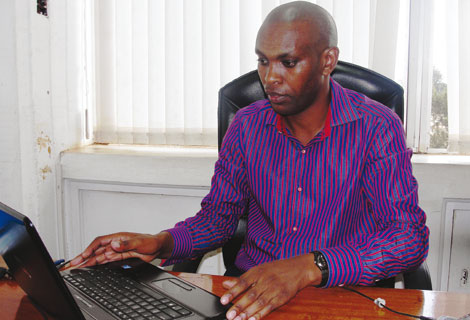By Eric Wainaina
Kenya: Coming up with an income-generating project is the easy part — at least compared to finding the funds to implement it.
There is no shortage of great ideas in Kenya, particularly among the youth, but poverty, difficulty accessing credit and a lack of information have denied many innovative entrepreneurs the chance to showcase their brilliance.
And this is where Mr Daniel Kimani comes in.
After years of watching his neighbours and peers in rural areas struggle to make a decent life for themselves, he knew it was time he actualised an idea he first had in 1999 as a third year student at university.
He was going to set up a microfinance institution.
“I thought of the idea because, when I was a student, I was worried that I would not get a job. However, even though I got one, I had many friends who were still unemployed. They gave me the impetus to set up an organisation that would empower them,” Mr Kimani said.
He had heard his friends discuss the businesses they would get into if they had the capital, so he knew he would be addressing an existing need.
Kimani, then a pharmacist, figured the best way to roll out his idea would be by making it possible for people to access microcredit at low rates and help them start sustainable income-generating projects. This would have the added benefit of tackling the unemployment menace.
Solid plan
In 2004, with a solid plan in place, he quit his job and started the Kenya Entrepreneurship Empowerment Foundation (KEEF).
Of course he had his detractors who said KEEF would never succeed as microfinance. It is hard enough for banks with billions at their disposal to chase after customers they have given loans to, they said, so how much more difficult would it be for a small start-up?
But nine years down the line, KEEF is not only a thriving institution, but it has also turned around the fortunes of thousands of its members.
So how did Kimani get started?
“I sold the idea to two other like-minded people and we managed to raise capital of Sh3 million. We started the microfinance in 2004 and in one year’s time, we had recruited 300 members,” he said.
Stay informed. Subscribe to our newsletter
Today, he said the capital has increased to more than Sh56 million, enabling KEEF offer loans to any of its members without difficulty.
The organisation, which has its head offices in Kiambu town, serves Rift Valley, Eastern, Central and Nairobi regions.
It offers business development, school fees and farming loans to groups and individuals. The amount advanced ranges between Sh6,000 and Sh500,000.
To be a member of KEEF, one has to be a member of a group — this could be a church or merry-go-round (chama) group, or just a group of people with common interests and innovative ideas.
“Our loans are paid back monthly. For a group, the interest charged is 0.7 per cent, and for an individual, it is 5 per cent. Our main target clients are youth, women and men interested in business, agriculture or technology,” Kimani said.
Ms Ruth Wangui from Tin’ganga Village told Business Beat that KEEF helped her get into dairy farming through her Makenga Women’s Group, which joined the organisation in 2007.
Ms Wangui first took out a Sh10,000 loan for a water pump, and later borrowed another Sh10,000 to buy a calf. After she paid off the money, she was advanced a Sh100,000 loan that she used to buy a cow and chaff cutter.
“I don’t regret joining KEEF because I was able to start an income-generating project that I would not have been able to because I could not raise the capital required,” she said.
Kimani says the interest charged on loans remains with the group, becoming a source of income for them. The principal amount advanced, however, goes back to KEEF.
But, groups are charged a Sh3,000 monthly fee, irrespective of whether they have taken out a loan or not.
Ms Jane Wairimu from Githiga Village in Githunguri also joined KEEF in 2007 through Neema Women’s Group. She has since started growing cabbages and tomatoes, and got into dairy farming.
“I first took Sh50,000 and bought a cow and pipes to start horticulture farming. Later, I borrowed Sh130,000 and I was able to buy a water pump, which has helped me irrigate my farm,” she said.
Ms Wairimu sells her cabbages and tomatoes in secondary schools and at the local market.
The microfinance has field officers who visit groups to offer training on entrepreneurship and financial management.
Nationally, there are dozens of registered microfinance organisations, and to survive in the competitive business, one has to offer affordable products and have innovative strategies that will attract clients.
Kimani has a mobile banking system that allows his clients to transact their business without visiting his office.
He sends loans through mobile money platforms, and members can make monthly repayments or send the Sh3,000 fee the same way.
Kimani is also able to quickly withdraw cash and send it on to KEEF members whose loan requests have been approved without physically moving from his office.
“This has helped us penetrate remote areas where the poverty index and need for income-generating activities are high.”
[email protected]
 The Standard Group Plc is a
multi-media organization with investments in media platforms spanning newspaper
print operations, television, radio broadcasting, digital and online services. The
Standard Group is recognized as a leading multi-media house in Kenya with a key
influence in matters of national and international interest.
The Standard Group Plc is a
multi-media organization with investments in media platforms spanning newspaper
print operations, television, radio broadcasting, digital and online services. The
Standard Group is recognized as a leading multi-media house in Kenya with a key
influence in matters of national and international interest.
 The Standard Group Plc is a
multi-media organization with investments in media platforms spanning newspaper
print operations, television, radio broadcasting, digital and online services. The
Standard Group is recognized as a leading multi-media house in Kenya with a key
influence in matters of national and international interest.
The Standard Group Plc is a
multi-media organization with investments in media platforms spanning newspaper
print operations, television, radio broadcasting, digital and online services. The
Standard Group is recognized as a leading multi-media house in Kenya with a key
influence in matters of national and international interest.








